Feng Shui practice using Buddhist mudras
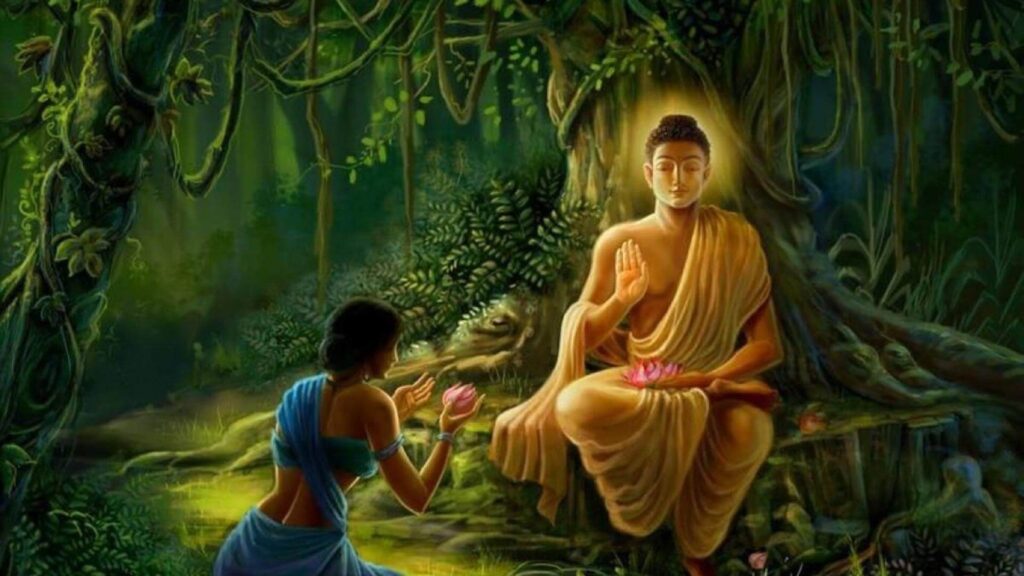
What is mudra? A Buddhist mudra is a Sanskrit word that means sign. You may have used a Buddhist mudra in your yoga class. Or if you look at any images of the Buddha, he is always holding a mudra. On the superficial level, a mudra indicates as a hand gesture. However, mudras have more profound spiritual significance. You could even say that your life, or your home, can be a mudra. It can be a symbol of great meaning. You will learn Buddhist mudras in Feng Shui practice here.
Buddhist imagery applied in the feng shui of your home as a spiritual reminder. The Buddha represents the potential for true happiness and goodness. It was inherent within each human and every sentient being. If you want to take it a step further, select a deity to display in your home holding a particular mudra to enhance your spiritual aspiration.
When it comes to feng shui mudra, Buddhist imagery is not at all a requirement. However, if it’s something that you’re attracted to, you’re reading the right article! The imagery of any of the mudras (or even making the mudras) may support any area of your home. Here are some commonly used Buddhist mudras and their meanings.
Decorating a home with the serene energy of Buddha is one of the many beautiful additions that feng shui mudra brought into the Western decor. The focus on decorating with specific items that bring good energy — and doing that with intent and full awareness — is the basis of most feng shui work, and the variety of Buddha sculptures and images is not an exception.
01. Dhyana: Meditation Mudra in Feng Shui practice
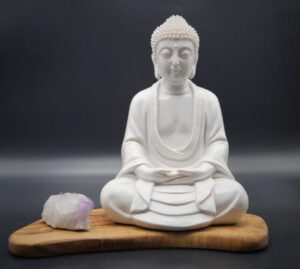
The dhyana (or meditation mudra) in the Mahayana tradition of Buddhism is a path of compassion for all living beings. With this hand gesture, you place the right hand on top of the left hand, palms face up, and thumbs are lightly touching. The thumbs touch to symbolise the union and enlightenment of masculine and feminine in mind, body, and spirit. Typically this mudra is depicted with the hands resting in the lap or at the heart center.
Best placement: These Buddhist mudras connect to meditation and contemplation. They would support the meditation area of your home as a feng shui practice.
02. Bhumisparasa: Earth Touching Buddhist Mudra in Feng Shui practice
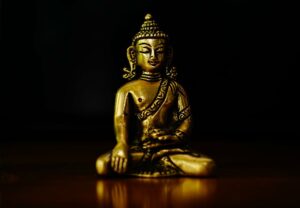
Bhumisparsha, the earth touching mudra, is one of the most well-known mudras. You will often see Shakyamuni, the historical Buddha, in a seated posture with this mudra. The right hand is poised with the fingertips downward and “touching the earth”, with the palm facing inward. The left hand is in the meditation (dhyana) mudra. When the Buddha became enlightened, he touched the earth with this mudra during his meditation. The earth was touched and witnessed the awakening.
Best placement: Since the Buddha touches the earth, this is a Buddhist mudra that can ground and support you in any room of the home. The center of your home is also a recommended spot since it’s connected to the earth element. It is the best feng shui practice by using this mudra.
03. Vitarka: Teaching or Discussion Buddhist Mudra in Feng Shui practice
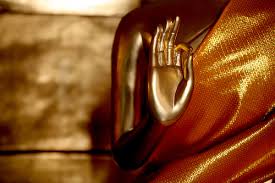
The vitarka (teaching or discussion) mudra with Buddhist iconography symbolises the transmission of the dharma of the Buddha’s truth teachings. The thumb and index finger touch in this mudra, creating a circle that symbolises an uninterrupted flow of wisdom. The other three fingers are pointing up towards the heavens with the palm facing outward. This is at around chest level.
Best placement: This Buddhist mudra can invite receiving and discussing teachings for growth and awakening into your life. Rooms such as a library, study, and or the Gen/Knowledge area of the home would benefit from this mudra’s imagery.
04. Abhaya: Fearless Mudra
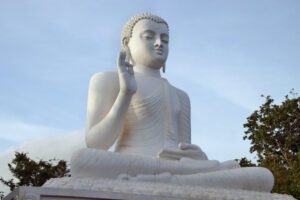
The Abhaya mudra is a symbol of fearlessness and protection. The left hand is in the meditation (dhyana) mudra, while the right hand is upright with the palm facing outward. All fingers are pointing up towards the heavens. Typically the right hand is at chest or shoulder level.
Best placement: This mudra is related to the notion of fierce compassion, where you can let go when it’s necessary. This mudra may help your home when you need to strengthen your boundaries while still opening your heart with confidence. Boundaries are related to the earth element, and so this mudra can invite more fearlessness in how you engage with the world.
05. Dharmachakra: Dharma Wheel Buddhist Mudra
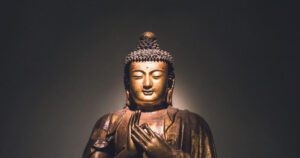
The word dharmachakra refers to the turning of the wheels of teachings frp. Besides, it relates to the Buddha and how they bring into the world. Both hands are important in this mudra. The right index finger touches the right thumb, and the left index finger touches the left thumb so that two circles (wheels!) created. The left palm is facing inward in front of the right palm, which is facing outward. This mudra is typically in front of the heart.
Best placement: The Buddhist had used this mudra when he first taught after his enlightenment. A wheel rotates and so represents movement and transition. Similarly, the placement of the dharma chakra mudra in your home can inspire movement and flow.
